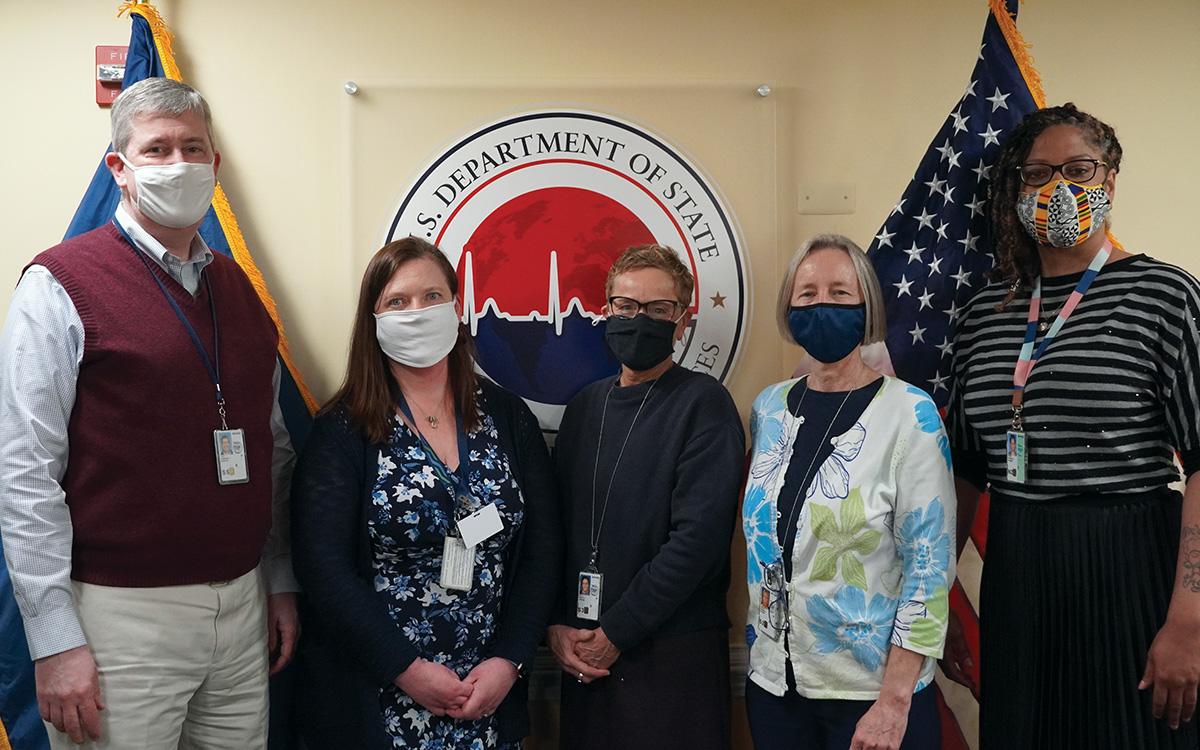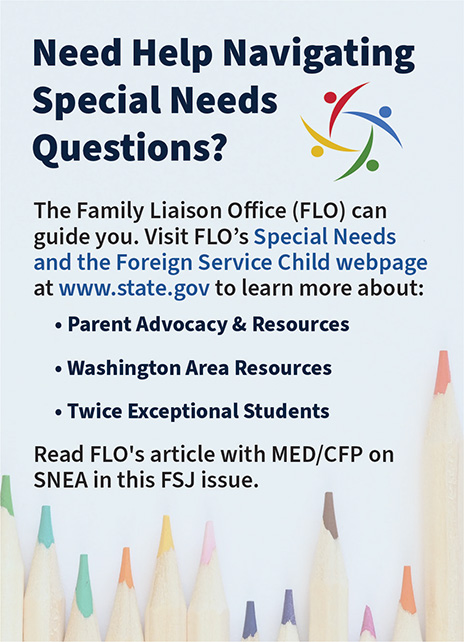What’s New with Special Education Allowances?
The Family Liaison Office Talks with the Office of Child and Family Programs
BY CHARLOTTE LARSEN

The MED/CFP team. From left, Dr. Charles Lilly, Michele Schurtz, Nancy Kelly, Dr. Barbara George and Monique Perry. Not pictured: Dr. Ruth Imershein, Emili Kuchler, Dr. Tera Ford and Salma Zaki.
U.S. Department of State
Bidding on one’s next assignment can be a daunting task for any Foreign Service family. It can be even more complex when education options in overseas settings for children with special needs are a part of that decision.
The State Department’s Office of Child and Family Programs (known as CFP) under the Bureau of Medical Services (MED) works together with parents and overseas MED medical staff members to ensure children’s psychological, behavioral health and special educational needs are identified and appropriately assessed. The goal is to have an effective treatment and education plan established in advance of and during overseas assignments.
Once the need for special education services is determined, families can apply for the Special Needs Education Allowance (known as SNEA). In the past, parents have faced challenges with this process; thanks to their advocacy, the department has put in place new procedures and updated guidance to improve application processing time, added staffing with geographical responsibilities, improved electronic reimbursement procedures and adopted a new appeals process.
The Bureau of Global Talent Management’s Family Liaison Office’s education and youth team (E&Y) works closely with CFP and can assist parents in navigating the SNEA process. Recently, FLO spoke with CFP to discuss available resources, previous challenges and new procedures to better serve all FS employees under chiefof- mission authority and their families. In April, as education and youth program officer of the Family Liaison Office, I conducted a written interview with Deputy Chief Medical Officer for Mental Health Programs Charles J. Lilly, M.D., of the State Department’s Bureau of Medical Services. We discussed new staffing and procedures in support of the Special Needs Education Allowance.
—Charlotte Larsen, FLO
It Takes a Team
Charlotte Larsen, FLO: The CFP team has recently expanded. Can you tell us about the team and their roles?
Dr. Charles J. Lilly, MED: The MED CFP team currently consists of one part-time child psychiatrist, two clinical psychologists, one education program specialist, one social worker, a nurse liaison and administrative support. The clinical psychologists, education program specialist and social worker have all been assigned geographic regions to support development of a knowledge base of available resources in their respective regions.
The nurse liaison and education specialist positions were new for CFP in 2020. The education specialist has brought a wealth of knowledge and experience regarding special educational programs and services in U.S. public school systems. The nurse liaison provides a primary point of contact for all referrals and SNEA applications, and will help CFP focus on how we can best serve the needs of families overseas.
FLO: What was the impetus for the expansion?
CFP: Through the combination of staff attrition and the hiring freeze that began in 2016, CFP had dwindled to one full-time social worker and one part-time psychiatrist. During this period, the program continued to receive a similar number of SNEA applications and educational and mental health clearance consultation requests.
This led to significant processing delays and related dissatisfaction. While the staffing issues caused significant problems, they also gave CFP the opportunity to reevaluate how the program was operating and to build a more diverse team of professionals.
FLO: You mentioned the addition of the “nurse liaison.” What specific role will the nurse liaison play in assisting families through the SNEA process?
CFP: The new nurse liaison position is intended as a primary point of contact for clinicians and families currently serving or planning to serve overseas. Prior to this, communication with CFP had been much more disparate. The nurse liaison position has allowed CFP to work directly with families, helping them to understand the SNEA process and obtain required support documentation, thus streamlining the process.
FLO: How does CFP look at information parents obtain from their own research? For example, if a parent finds a school, therapist or other resource at a post that is not currently on CFP’s radar, will CFP consider that information in approving the post or allowing the parent to make use of those services?
CFP: We always welcome the involvement of parents in helping us make the most informed clearance recommendations or SNEA authorizations for their children. This includes the family providing the names, credentials and contact information for schools, therapists or other resources from their own research. In collaboration with our overseas medical staff, including regional medical officers (RMOs), regional medical officer psychiatrists (RMO/Ps), other health care providers and the Office of Overseas Schools’ regional education officers (REOs), we will then seek to understand the qualifications of any clinicians or capacities of schools overseas to manage the children’s needs.
Because of the wide variability in expertise and capacity of some of these resources overseas, we may not be able to approve them for use in every case.
FLO: The clinicians now have regional responsibilities that mirror those of the REOs from the Department of State’s Office of Overseas Schools. What is the benefit of this?
CFP: The regional assignments will allow the CFP clinicians to develop a much deeper understanding of resources in each region and work more closely with their counterparts in the OOS. We hope that when travel restrictions relax, our CFP clinicians will have the opportunity to meet school officials and provide education and guidance regarding CFP and SNEA funding to schools, health units and embassy communities overseas.
Simplifying Things
FLO: I understand that the SNEA referral process was recently simplified. How will this benefit FS families?
CFP: The CFP nurse liaison has been central to improving our processes by addressing all requests and inquiries, following up with families, assisting with gathering required documentation, assigning SNEA cases for review when all the documentation has been submitted, monitoring and tracking any incomplete requests, and elevating any inquiries to the MED/CFP SNEA adjudicators when further guidance is necessary.
When families identify a problem or potential problem with a child’s education while overseas, CFP strongly encourages them to discuss this with the embassy health unit staff, who will then schedule an appointment with the RMO/P. If, through that discussion, SNEA seems an option, we have simplified the RMO/P referral process.
In the new process, we only ask for basic eligibility criteria as described in the Individuals with Disabilities Education Improvement Act of 2004. We specifically ask, “Does the child have an actual or suspected diagnosis in one of the 13 categories defined by the statute; and if so, how does the diagnosis adversely affect the child’s progress in school?”
Additionally, we want to understand what, if any, school interventions or supports have been helpful or are being requested.
The simplification of the SNEA referral process identifies children with needs and gets their families in contact with CFP as quickly as possible, rather than waiting for parents, schools, clinicians and the RMO/P to gather required documentation prior to submitting the SNEA referral.
The CFP nurse liaison then works directly with families to assist in gathering required documentation.
FLO: What is being done to reduce the lengthy list of required paperwork for parents? Are there other ways to simplify things, particularly for those who have already established long-term needs for their children in the past?
CFP: CFP recognizes this is a problem, and we are working to streamline the clearance consultation and SNEA application processes to make them more efficient and easier for our families. Families do not need to forward duplicate documentation for consideration in clearance and SNEA processes. We actively try to anticipate future needs and work with parents ahead of time to identify what documentation will be required to avoid a difficult rush to obtain required information.
If families have questions regarding the clearance referral and SNEA application processes, or are having difficulty obtaining requested information, please notify the CFP team at MEDCFP@state.gov.
FLO: What is being done to ensure that information resources on the State Department’s intranet site reflect the latest guidance?
CFP: The CFP team recently updated the DoS intranet site and are in the process of updating the internet site. We anticipate the CFP internet site will be available by early summer.
We continue to actively collaborate with the Office of Overseas Schools, Family Liaison Office, the Office of Allowances, and our overseas medical teams to define and present the most up-to-date information possible in a way that will be most useful.
FLO: How does CFP work with the Office of Overseas Schools?
CFP: CFP meets monthly with OOS to exchange information on related concerns. This has helped CFP clinicians develop a more detailed understanding of the overseas environment.
The recent pandemic highlighted the fragility of some of the resources we relied on in some overseas environments that quickly became unavailable as many schools saw dramatic reductions in enrollment. The OOS maintains much closer and more frequent contact with these schools and was able to communicate with CFP as these changes were occurring.
Through their frequent contact with embassy communities and families serving or planning to serve overseas, OOS also brings to CFP many of the concerns and questions that they receive regarding our services. The REOs’ educational expertise, firsthand knowledge of their regions and collaboration with schools overseas continue to be fundamental in determining post resource capabilities for special education.
For additional information, visit the OOS website or email OverseasSchools@state.gov.
The Nitty-Gritty
FLO: What are the basic eligibility criteria for a student to receive SNEA?
CFP: The basic eligibility criteria include a medical diagnosis or learning disability that has a significant impact on the child’s ability to access a general education curriculum.
These are not the only criteria, however. As per the Individuals with Disabilities Education Improvement Act of 2004, on which we base CFP processes, we also require the child to have an individualized education plan (IEP), which details services required to access the general curriculum. Examples of these services include speech and language therapy, occupational therapy and specialized educational instruction, among others.
The services must be defined as required in the IEP; and the IEP must detail the metrics used to evaluate the child’s progress in the various deficiencies the services are intended to address. Many schools overseas do not have experience developing a detailed IEP. CFP recognizes this and will provide guidance to families when equivalent documentation is needed.
To grant SNEA, CFP must understand what services are required, how the school and external specialists will provide the services, and how progress will be measured.
FLO: Timely responses are paramount for families while bidding. What can families realistically expect from your office in terms of getting their inquiries answered?
CFP: When families contact the CFP mailbox, MEDCFP@state.gov, they receive a response within five business days. With SNEA applications, the nurse liaison will maintain communication with families until required documentation is compiled. The case is then assigned to one of the CFP specialists to complete adjudication.
Processing times vary based primarily on the time required to compile the necessary documentation. Possible delays may occur because of incomplete documentation, pending identification of external providers, or if it is not clear which requested services will be provided at extra cost (above basic tuition).
Once the case is assigned to a CFP clinician to complete adjudication, the family can expect a response within two to four weeks. This timeline varies based on the complexity and construction of a complete application.
Now that we are fully staffed, we hope to be able to assess response times more accurately and identify which aspects of the process require the most time. Families are encouraged to contact CFP with questions or problems, including delays in obtaining requested documentation.
FLO: What is the difference between a partial- and a full-year SNEA cable?
CFP: Beginning in 2020, CFP, in collaboration with the Office of Allowances, developed a partial-year services cable. The partial-year cable is an option families can choose that allows for continued reimbursement of required services defined in the learning plan from the prior school year when there is a delay in developing and receiving an updated learning plan for the current year.
Some of our FS families have selected this option when moving to a new post, or if the current school is delayed in developing an updated learning plan for the current school year.
All partial-year SNEA cables will cover school tuition for the full school year and will list SNEA-authorized educationally required services that are at cost above tuition for the first half of the school year.
Once the new or updated plan is created, families forward this information to CFP, and our specialists review and then amend the cable to reflect the eligible services and supports described for the remainder of the school year.
FLO: Can you tell me more about the new E2 reimbursement process for SNEA claims? Why was it created?
CFP: The E2 Local Travel module in the E2 travel system allows employees to scan and upload their paid receipts for SNEA-eligible services and submit these for reimbursement. The new SNEA voucher process centralizes the initial “approver” role for reimbursement claims to the CFP clinicians who authored the cables detailing SNEA-eligible services and expenses, thus increasing the efficiency of the process.
Using E2 in this way also provides families much greater privacy and control over a reimbursement process that previously involved much more interaction with nonclinicians. The claims will first be routed to MED/CFP for review and approval; then to the post finance office for fiscal data and verification of funds under the allowance; and finally, to the post support unit for certification.
FLO: Is there a formal appeals process? How do families appeal a SNEA denial?
CFP: MED established a SNEA appeals process in 2020. When a family receives an adverse SNEA decision (either complete or partial denial of requested services), they are informed of the appeals process.
If desired, the family requests to begin the appeals process by contacting the Medical Review Panel chair. The family provides a detailed, written description of the reasons for appeal to the MRP chair, who passes this information to the panel members, including two overseas RMO/Ps and one domestic or overseas RMO who have not had any prior contact with or direct knowledge of the case.
A CFP specialist presents the case to the panel and answers any questions members have. Panel members then vote, and their recommendations are presented to MED’s chief medical officer who issues a final determination. The MRP chair then notifies the family.
For More Information. When families begin the process of navigating SNEA, FLO wants them to have a clear idea of how things work and where to go for answers. We encourage anyone with additional questions to reach out directly to the CFP team and to FLO for continued support and resources.
Contact the FLO E&Y team at FLOAskEducation@state.gov, by phone at (202) 647-1076 or online at www.state.gov/flo/education.
Families may find it helpful to read through the 3 FAM 3280 SNEA and the DSSR 271 Education Allowance.
Read More...
- “What’s Next for SNEA?” by Donna Scaramastra Gorman, The Foreign Service Journal, April 2020
- “Response—The Demise of MED’s Child and Family Program,” by James Brush, The Foreign Service Journal, September 2018
- “Response from MED—Our Commitment to Foreign Service Families,” by Dr. Charles Rosenfarb, The Foreign Service Journal, May 2018














